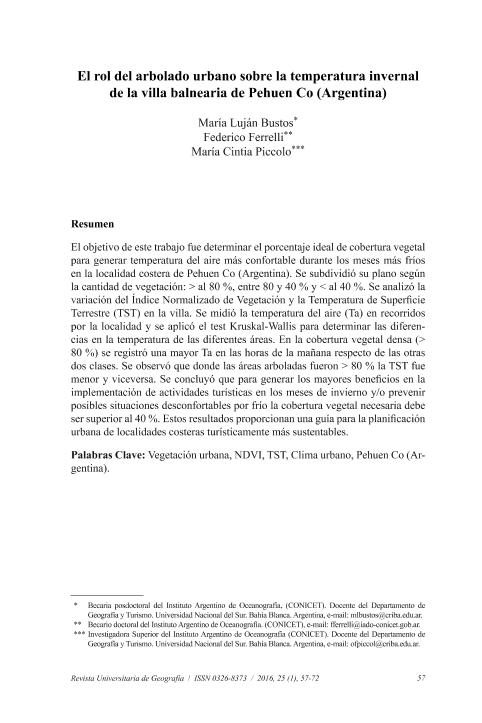Artículo
El objetivo de este trabajo fue determinar el porcentaje ideal de cobertura vegetal para generar temperatura del aire más confortable durante los meses más fríos en la localidad costera de Pehuen Co (Argentina). Se subdividió su plano según la cantidad de vegetación: > al 80 %, entre 80 y 40 % y < al 40 %. Se analizó la variación del Índice Normalizado de Vegetación y la Temperatura de Superficie Terrestre (TST) en la villa. Se midió la temperatura del aire (Ta) en recorridos por la localidad y se aplicó el test Kruskal-Wallis para determinar las diferencias en la temperatura de las diferentes áreas. En la cobertura vegetal densa (> 80 %) se registró una mayor Ta en las horas de la mañana respecto de las otras dos clases. Se observó que donde las áreas arboladas fueron > 80 % la TST fue menor y viceversa. Se concluyó que para generar los mayores beneficios en la implementación de actividades turísticas en los meses de invierno y/o prevenir posibles situaciones desconfortables por frío la cobertura vegetal necesaria debe ser superior al 40 %. Estos resultados proporcionan una guía para la planificación urbana de localidades costeras turísticamente más sustentables. The aim of this study was to analyze the influence of vegetation on the spatial distribution of winter air temperature in order to determine the appropriate percentage of vegetation necessary to create a more comfortable environment during the coldest months in Pehuén Co (Argentina). The town was sub-divided into three regions according to the amount of vegetation: greater than 80%, between 40 and 80% and less than 40%. The Normalized Difference Vegetation Index (NDVI) and the Land Surface Temperature (LST) were applied. Air temperature data were analyzed using Kruskal-Wallis test in order to determine the relationship between air temperature and the vegetation coverage. The heavily vegetated region (>80%) presented an air temperature increase during the morning. The LST presented lower values in regions with more vegetation. It was concluded that the appropriate percentage of vegetation necessary to generate touristic activities in the winter months and/or prevent possible uncomfortably cold situations for people outdoors must be greater than 40%. These results provide a guide to urban planning in sustainable coastal towns.
El rol del arbolado urbano sobre la temperatura invernal de la villa balnearia de Pehuén Co (Argentina)
Título:
The influence of urban vegetation on winter temperature in Pehuen Co coastal town (Argentina)
Fecha de publicación:
01/2016
Editorial:
Universidad Nacional del Sur. Departamento de Geografía y Turismo
Revista:
Revista Universitaria de Geografía
ISSN:
0326-8373
Idioma:
Español
Tipo de recurso:
Artículo publicado
Clasificación temática:
Resumen
Palabras clave:
Vegetacion Urbana
,
Ndvi
,
Tst
,
Clima Urbano
Archivos asociados
Licencia
Identificadores
Colecciones
Articulos(IADO)
Articulos de INST.ARG.DE OCEANOGRAFIA (I)
Articulos de INST.ARG.DE OCEANOGRAFIA (I)
Citación
Bustos, María Luján; Ferrelli, Federico; Piccolo, Maria Cintia; El rol del arbolado urbano sobre la temperatura invernal de la villa balnearia de Pehuén Co (Argentina); Universidad Nacional del Sur. Departamento de Geografía y Turismo; Revista Universitaria de Geografía; 25; 1; 1-2016; 57-72
Compartir




